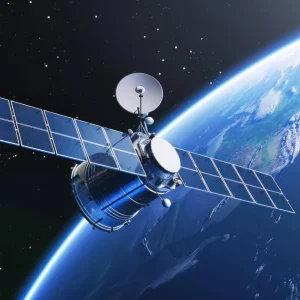
On a warm evening in February 2019, Caleb Henry watched as OneWeb launched its first satellites into low Earth orbit (LEO) from the Guiana Space Center in Kourou, French Guiana. Four years later, he embarked on another lengthy journey, this time to India’s Satish Dhawan Space Centre, to watch the satellite broadband pioneer’s 18th launch. It was “once-in-a-lifetime” — or rather, perhaps, twice-in-a-lifetime — experience for Henry, but also a symbolic moment for OneWeb, which finally reached the required threshold for global broadband coverage, thus achieving a long-awaited (and much-delayed) ambition.
“I went to the first launch,” says Henry. “I wanted to attend the last one as sort of a poetic capping of that experience.”
The faces at this year’s launch, Henry recalls, were almost entirely different from those in attendance in 2019 — testament, perhaps, to how much OneWeb has changed since sending its first six mini-fridge-sized satellites into orbit aboard a Russian-built Soyuz rocket, carefully adapted by launch provider Arianespace to cope with the tropical conditions of French Guiana.
As director of research at space-focused investment firm Quilty Analytics, Henry has been closely watching the British satellite company’s development — and he doesn’t think they have any time to rest on their laurels. “Even though they’ve reached this target and they’re now able to execute on business goals they’ve been seeking to accomplish for years, they still don’t have a chance to sit still,” says Henry. “They’re still in the middle of a very competitive environment — one that is already compelling them to create a second-generation network of newer satellites.”

What challenges is OneWeb up against?
Founded in 2012 by American entrepreneur Greg Wyler, OneWeb finally began launching satellites in 2019. Then came the pandemic. After failing to raise enough money to finish building and deploying the remaining 90% of its satellite network, OneWeb filed for bankruptcy, only to be brought back from the brink by an unlikely £400m bailout from the UK government and Indian conglomerate Bharti Enterprises. Eyeing up its nascent satellite constellations as an ideal replacement for the EU’s Galileo GPS system, industry insiders believed the takeover could be the first step in a British bid for space supremacy.
It hasn’t exactly panned out that way. Last year, OneWeb announced its merger with French rival Eutelstat, creating a distinctly European satellite powerhouse boasting satellite fleets in both low Earth and geosynchronous orbit. As of 20 May 2023, the company has launched 634 satellites into LEO and is aiming to roll out global broadband coverage by the end of 2023. It remains to be seen, however, how long OneWeb can remain competitive in the crowded and costly market of satellite broadband — one that might be increasingly dominated by global power-players like SpaceX and Amazon.
It is, after all, in a very expensive business. Although it costs less to deploy LEO satellite constellations than the geostationary systems that have powered much of our telecommunications since the 1980s, OneWeb will need to regularly replenish its fleet. Indeed, the company is already contemplating launching a second generation of LEO constellations — especially in light of the unforeseen delays in establishing its first. “There’s a hell of a lot of launching to do,” says Professor Sa’id Mosteshar, director of the London Institute of Space Policy.
The rapid pace of development in digital technology — not to mention our insatiable demand for bandwidth — also means that OneWeb will need to keep introducing newer satellites in future in order to stay competitive. “There’s a business model here that is yet to be proven out,” argues Simon Potter, head of investment and financial consulting at analytics firm Bryce Tech.
There’s also the ever-present question of SpaceX’s Starlink, the biggest name in satellite broadband. “I think that kind of competitor, particularly if it’s not competing on a level playing field, is going to be a huge obstacle to overcome,” says Mosteshar. “It’s not just that [OneWeb] needs to make a profit. The other side of the coin is that Starlink doesn’t have to make a profit, because it will still benefit SpaceX and Elon Musk through loss allowances that he’ll be able to set off against other income.”
Mosteshar is also concerned that OneWeb’s market might dry up — especially as we improve the capacity of our terrestrial broadband systems. “Yes, you can have high-speed broadband in the middle of the desert, but there aren’t many people living there,” says Mosteshar. Potter agrees, arguing that the market might indeed already be full. “The really big question is, how many of these large constellations do we need going forward?” says the analyst. “Given current patterns of consumption and the costs of deploying these systems, it’s hard to see how that number is much bigger than two or three.”

Henry, however, believes that OneWeb has already successfully differentiated itself from Starlink. While the latter has targeted individual consumers, OneWeb has marketed its services to global telecoms companies, to governments and major enterprises seeking remote uplink options, whether on cruise ships, airlines, mines or offshore oil rigs.
He also thinks there’s plenty of room for competitors. “It’s not going to be a winner-takes-all market,” says Henry. “The satellite industry cannot connect everyone on Earth at this point in time, even with all the satellites up there… You’re going to continue to see competition amongst these different players. You’re also going to see some differentiation in terms of what kinds of customers they serve.”
Massimiliano Ladovaz, OneWeb’s CTO, is equally confident. “There is absolutely room for competition in the satellite connectivity market,” he says. “The demand for more connectivity services, resiliency, and redundancy is only continuing to increase, and we are seeing a growing need for more services, not fewer.”
“I think this will be like any other shakeout in any other business,” says Paul Kostek, a senior member of the Institute of Electrical and Electronics Engineers (IEEE) and an advisory systems engineer with Air Direct Solutions. As our technological capabilities improve, he argues, it might even become easier for smaller competitors to get a foothold in the market. “The price is dropping,” says Kostek. “Even the [necessary] ability to launch a payload is dropping.”
Reach for the stars
Where next, then, for OneWeb? Satellite broadband might need to be integrated with terrestrial internet services in the near-term future if companies want to secure a wider client base, says Kostek. Consumers will be looking for a smooth transition, which will require clear collaboration between different kinds of providers. “They won’t want to know that they’ve switched from a satellite to a ground station or vice versa,” he says. “All they want to know is that their phone call isn’t being interrupted and their data transfer isn’t being corrupted.”
In such a crowded market, satellite constellations like OneWeb’s might also need to start serving multiple functions — including communications, remote-sensing, and other hosted payloads — in order to secure long-term economic viability. “It doesn’t necessarily have to all be about broadband from space,” says Potter.
Neither should OneWeb’s future be defined entirely by market forces. Demand for its low Earth satellite constellations might also be dictated by the political wills of various governments — some of which have decided it’s in their national interest to develop sovereign capabilities in this field. “I don’t expect economic success to be the only thing that keeps [these satellites] flying,” says Henry.
Mosteshar is less optimistic. Cybersecurity is an ever-present challenge, he points out, since “you’re putting your infrastructure outside your jurisdiction,” he says. “We obviously have enough problems with the terrestrial internet.” There’s also just the question of sheer cost, both financial and environmental.
Is sending our infrastructure into space even worth it, especially when we’re making big improvements in terrestrial capabilities? Space might seem sexy now, says Mosteshar, but that’s not a good-enough foundation for a policy or major investment. “We ask, ‘What are we going to do? How are we going to do it?’,” he says. “Not very often does anybody ask: ‘Why?’”






